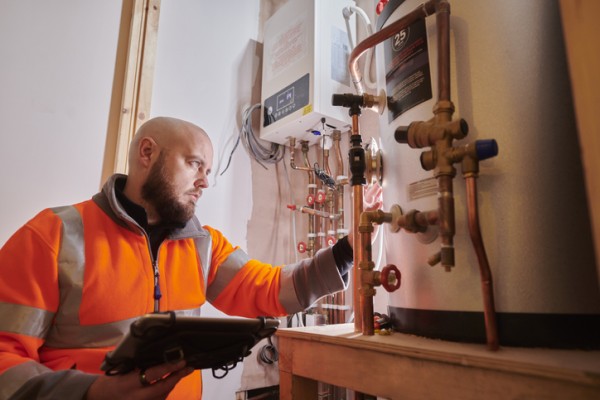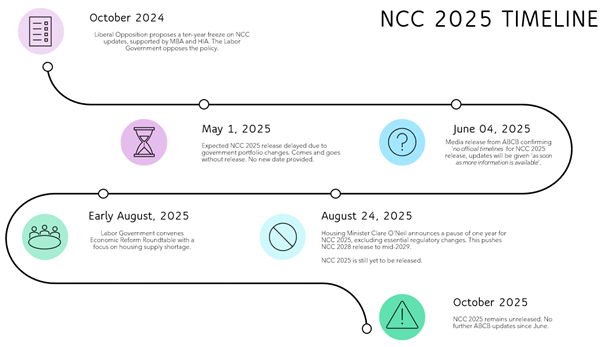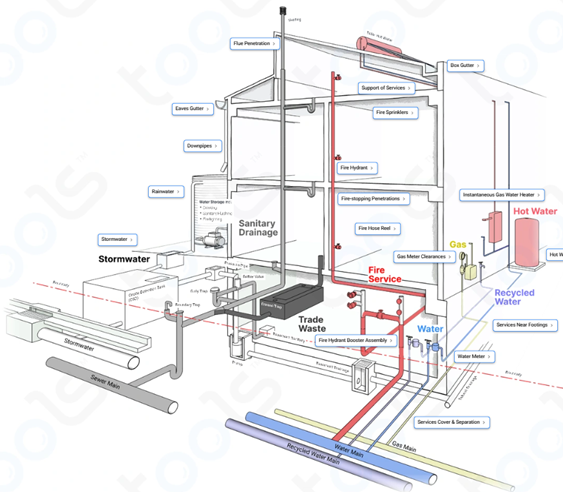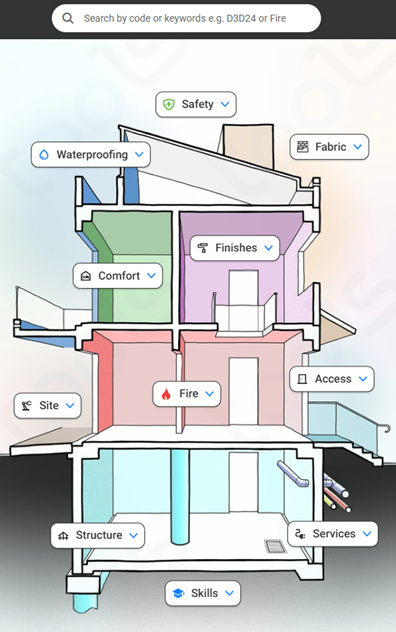NCC 2025 – Delays, politicising, pauses, confusion

Love it or hate it, the National Construction Code (NCC) defines our work as plumbers and engineers. From every roughed-in bathroom, multi-storey stack, to every gutter and downpipe. But it is not immune to red tape, bureaucracy and politicisation. Recent iterations have become more complex and have been subject to increasing criticism from the political class, construction industry and prospective home buyers.
Originally called the Building Code of Australia, the NCC was first issued as a 300-page, single-volume code in 1988, with States and Territories progressively adopting it during the early 1990s. Fast forward to 2025, and the NCC in its current format is now a 2,000-page, three-volume (Vol 1, Vol 2 & Vol 3) code cited as being ‘unworkable for our builders’ by current Labor Government Housing Minister Clare O’Neil.
The NCC was updated yearly until 2015, until the Australian Building Codes Board (ABCB) changed to a three-year update cycle to reduce the frequency of changes to building requirements.
With each new edition, the outcomes vary; sometimes minimal and sometimes drastic, with unforeseen, far-reaching effects. The most impactful NCC edition was the most recent one, with the NCC 2022 said to cost home owners an additional $30,000 – $50,000 when building a home.
NCC 2025, to be released in 2026?
No, that is not a typo.
Presently, each new edition of the NCC comes into effect on 1 May of each three-year cycle. However, 1 May 2025 has come and gone without a new edition. The latest official update from the ABCB in June 2025 is that a release date for the new edition “is not available at this stage,” and that “practitioners should continue working in accordance with the NCC version and adoption timeline, currently in place in the jurisdiction relevant to their work.” The ABCB further promised that “we will provide another update when more information is available.” At the time of writing (October 2025), the aforementioned ‘adoption timeline’ has not yet been provided and there have been no updates. A reason for this has not been provided.
NCC pause – Adding confusion unto confusion
In October 2024, a freeze on unnecessary changes to the NCC was originally proposed for ten years by a Peter Dutton-led Liberal opposition. This idea was supported by the Property Council, Master Builders Australia (MBA), Housing Institute Australia (HIA), but was opposed by the Labor Party, with Minister for Industry and Science, Ed Husic, claiming that such a freeze would fail to protect Australians from “shoddy construction, like we saw with the Grenfell Tower inferno.”
Almost half a year later, in August 2025, an Albanese-led Labor Government hosted an Economic Reform Roundtable, which was soon followed by an announcement – a pause to further NCC updates. The suggested intent was to remove red tape and speed up housing approvals. Housing Minister Clare O’Neil argued that “in Australia, it takes longer to get approval for a home than it does to build one.” Ed Husic (who by this time had been dumped as Minister for Industry and Science and assigned to the backbench) still opposed the idea, accusing the Labor Party of “repeating the mistakes” of the Coalition. Liberal Party Shadow Treasurer Ted O’Brien accused the Labor Party of hypocrisy, first opposing and then stealing a Liberal Party policy.
The announcement of this pause has confused in the construction industry. Would the NCC 2022 be paused? Or will NCC 2025 take effect? Clarity on this was important, as it impacted which edition (2021 or 2025) of AS/NZS 3500 Standards should be used in the plumbing industry.
If you are to read the official announcement carefully, Housing Minister Clare O’Neil announced a pause to “further residential changes to the National Construction Code until the end of the National Housing Accord period (mid‑2029), following finalisation of NCC 2025.”
In plain speak, this can be interpreted as a pause to residential updates only, not commercial ones. The pause will commence after NCC 2025 is released, which will happen at a date not yet specified. The pause will only last one additional year, until mid-2029 (rather than the scheduled mid-2028 release).
The pause was seemingly not as drastic as it first sounded, and yet it was met with mixed responses.
The Housing Institute of Australia (HIA) supported the pause as “an important first step.”
Engineers Australia warned against an NCC freeze, stating that “updating the NCC regularly to reflect contemporary construction practices and lessons from past failures is not just a regulatory necessity – it’s a national imperative.”
The Australian Institute of Architects also responded negatively, raising concerns that “a pause in the NCC will not keep up with innovations that help us build better and quicker” and that “we’ll be left behind in the international market.”

The confusing timeline of NCC 2025
It’s not all doom and gloom, though. Despite the ABCB’s woes, plenty of the industry’s best and brightest are looking at ways to design and build better buildings, and to do this faster and more economically without compromising on quality. Modern technologies, software and apps are emerging to make lives easier. One example is Building Tools.
A welcome solution – Building Tools app
NSW-based architect, Jerry Tyrell, has created a welcome solution to the “sheer complexity” of the 2,000-word, three-volume NCC via a new Australian app called Building Tools, which is available on both mobiles and desktops.
The unique, innovative app provides over 320 clean, simple and interactive graphics for a vast number of construction disciplines, including carpentry, accessibility, thermal comfort, fire protection, plumbing, electrical, structural, waterproofing and more, with new content being added constantly.

Plumbing overview graphic, Building Tools app (used with permission)
Each informative graphic can contain as many as 30 pages of text, collating and simplifying the plethora of NCC rules, referenced building codes (such as AS3500), industry best practices and risk information. Users can switch between NCC editions (2022, 2025) that they wish to reference, with references in the app hyperlinked to full clauses in the NCC, or specific citation of a relevant reference document or Australian Standard. Additional guidance notes from industry best practice and code interpretations are provided too. When there is an update to the NCC or referenced Australian Standard, the information in Tools is updated in real time, ensuring the user has access to the latest amendments or addenda.
Tools allows for user feedback, commentary and correction, prompting the online community of industry professionals to validate or amend references, citations and guidelines. Tools has ISO 9001 Certification and maintains a log of code changes, highlighting new, amended or deleted clauses in each code plus also technical updates or clarifications. This provides robust quality assurance in design and construction.
This first-of-its-kind App is a perfect ‘tool’ to simplify & illustrate the overly complex and constantly changing building codes – allowing us to remain in step with a rapidly changing construction industry, including best practices. The app will eliminate endless mistakes, rework and productivity problems on-site and in engineering and design offices alike.
And, plumbing and construction students love it. It’s quickly becoming a major ingredient in the digital education platform for leading educators in Australia, such as TAFE NSW, Swinburne, RMIT and TAFE SA.

The Building Tools landing page comes in a structured, easy-to-understand format (used with permission)
On the Building Tools website, Jerry says: “Knowledge is the solution to our industry’s quality crisis. Millions of wonderful ancient buildings were built by proud designers and craftsmen using age-old best practices and wisdom. They didn’t need piles of confusing rules and regulations.”
Wrapping things up
As it currently stands, one thing is certain – the NCC 2025 is a hot mess. Here is an attempt to summarise a complex situation.
- NCC 2025 has not yet been released, with no update yet provided by the ABCB as to when it will be. Its arrival is due amid a housing supply crisis, coupled with mounting pressure to meet emissions reduction and energy efficiency targets.
- When released, it will be paused – not for ten years as originally proposed by a Liberal opposition (who take credit for the idea), but for one year as decreed by a Labor government. The intention of such a pause is well-meaning: To speed up housing approvals.
- Some industry stakeholders and bodies are supportive of this decision; others are opposed to it.
- The code has faced increasing scrutiny, targeted for its “sheer complexity”, and labelled ‘unworkable for our builders’ by Labor Government Housing Minister Clare O’Neil.
- There is reason for frustration, as the industry paces regulation at a breakneck speed, a speed at which the ABCB and NCC either cannot seem to keep up with or overshoots the mark.
- The release of the NCC 2025 edition carries more weight than previous iterations, largely due to the aforementioned factors and more.
- There is hope, though, through innovations such as the Building Tools app, brainchild of the mercurial Jerry Tyrell, which brings clarity and accessibility to the beast that is the NCC.
So, what exactly are the code changes that will affect the plumbing industry?
There are several in the 2025 editions of the NCC and AS/NZS 3500, which will be covered in another article for Plumbing Connection. Stay tuned.
